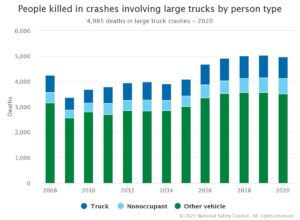Becoming a truck driver comes with its own set of complexities. Drivers are operating a bigger and slower vehicle on a road where cars only get smaller and faster all the time. Managing a truck effectively is a skill, and requires so much of the driver because of its inherent risks. Injury Facts from the National Safety Council state that 2020 saw 4,965 fatalities due to truck collisions on the road, and the majority of those deaths (71%), happen to the car driver that collided with the truck. Here is a chart detailing the fatalities that come from truck accidents:
Understanding the Basic Requirements
Truck drivers operate under federally recognized criteria that differs from the regular driver in many ways. The reason the requirements are so extensive is because, as mentioned already, the increased risk to others on the road needs to be taken seriously by the truck driver. Injury attorneys at Nicholson Revell, LLP state that truck drivers cause accidents through driver fatigue, demanding schedules, overloaded trucks, poor truck maintenance, intoxication, and more. Here are the basic requirements set for truck drivers to minimize disaster:
You Must be 21 or Older
There are a few exceptions to this age requirement, as some companies allow you to be 18, but the majority of professional trucking companies expect their drivers to be 21 and up.
You Must Provide a 10 Year Driving Record
You have to present a trucking company with your driving history up to 10 years (or when you first started driving, if it was less than 10 years ago), before getting hired. This includes tickets, accidents, and does not apply to one state. Your local DMV will be able to provide you with a report to submit before applying.
You Must Pass the Commercial Driver’s License (CDL) Exam
Truck drivers have to pass their own license exam, and obtain a separate license. Just like the regular driving test, you can gain access to training programs that will help you prepare for a three-part truck driving test, made up of a road test, vehicle inspection, and a backing test.
You Must Meet the Medical Requirements
The Federal Motor Carrier Safety Administration details criteria for commercial driver medical fitness. This has information on drivers with certain medical conditions (like diabetes and visual issues), as well as medications that they can/can’t be on, information on missing or impaired limbs, and where you can find a medical examiner in order to assess all of these aspects.
You Must Have a Clean Criminal Record
Like most jobs, a criminal record is a limitation for employment. If you have any motor vehicle-related felonies (DUIs, hit-and-run incidents, etc.), you will not be able to operate a vehicle.
Rules Of The Road As A Truck Driver
Considering the immense power behind the vehicle that a truck driver is in control of, it’s no surprise that there are some driving laws that apply strictly to truck drivers. This is to help ensure the safety of both the truck’s driver, as well as other individuals on the road. Some of these trucking rules of the road include:
Only Driving a Certain Number Of Hours a Day: In order to avoid fatigued driving, one of the most common causes of vehicle accidents, truck drivers are legally only allowed to drive for a certain amount of time in a day. Known as the Hours of Service Regulations, these rules are established and enforced by the Federal Motor Carrier Safety Administration to keep drivers from spreading themselves too thin while on the road and risking their and others’ safety.
Following Trucking Speed Limits: Because speed limits vary from state to state and even highway to highway, truck drivers should always be aware of the limit for trucks. They are typically different from passenger vehicles, as trucks are expected to go at a slower speed.
Stopping Due To Weather: In extremely dangerous conditions, truck drivers are taught and expected to either drive with extreme caution or stop driving entirely. This is because if a truck driver is involved in an accident in harsh conditions, a skilled truck accident lawyer can hold the company fully responsible for the crash because the driver wasn’t being as safe as possible.




No Comment